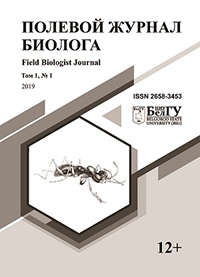Analysis of the economic value of vegetation ravine-girder complexes of the Belgorod region
DOI:
https://doi.org/10.18413/2658-3453-2019-1-1-55-63Keywords:
biological resources, carbonate soils, natural forage lands, community productivity, economically valuable plant species, cereal grains, legumesAbstract
Biological productivity of ecosystems is the most important resulting indicator characterizing the rate of biomass formation, which is based on the efficiency of using solar energy during photosynthesis. Since 2003, the Botanical Garden of the National Research University «BelSU» has been actively working to study the productivity of the steppe biome as a whole and its individual components. The most intensively conducted studies of the formation of productivity of natural phytocenoses ravine girder complexes, which are widely distributed in the region. Anthropogenic stress and climate change are increasing. This leads to the fact that monitoring the productivity of plant communities is of great importance, especially in the unstable conditions of areas with difficult terrain. A study of the state of vegetation and the accumulation of aboveground phytomass by various grass communities of beams and gully complexes allows using this data to monitor primary biological production and reproduction of biomass by communities as an essential component of the energy balance of ecosystems. The total amount of elevated phytomass accumulated during the growing season by various communities of gully-complex in various ecotopes ranges from 109.0 to 112.7 g / m2 – minimally on the southern slopes of exposure and as large as possible on the bottoms of the beams in places previously used for the cultivation of intensive perennial crops.
Downloads
References
Барицкая В.А., Чепинога В.В. 2014. Геоботаника и методы геоботанических исследований. Иркутск, 193.
Baritskaya V.A., Chepinoga V.V. 2014. Geobotanika i metody geobotanicheskikh issledovaniy [Geobotany and Geobotanical Research Methods]. Irkutsk, 193. (in Russian)
Вальков В.Ф., Денисова Т.В., Казеев К.Ш., Колесников С.И., Кузнецов Р.В. 2008. Плодородие почв и сельскохозяйственные растения: экологические аспекты. Ростов-на-Дону, Южный федеральный университет, 416 с.
Valkov V.F., Denisov T.V., Kaseev K.Sh., Kolesnikov S.I., Kuznetsov R.V. 2008. Plodorodiye pochv i sel'skokhozyaystvennyye rasteniya: ekologicheskiye aspekty [Soil Fertility and Agricultural Plants: Environmental Aspects]. Rostov-on-Don, Southern Federal University, 416. (in Russian)
Лакин Г.Ф. Биометрия. М., Высшая школа, 352.
Lakin G.F. 1990. Biometriya [Biometrics]. Moscow, High School, 352. (in Russian)
Маевский П.Ф. 2006. Флора средней полосы Европейской части СССР. М., Тов-во научных изданий КМК, 600.
Mayevsky P.F. 2006. Flora sredney polosy Yevropeyskoy chasti SSSR [Flora of the middle zone of the European part of the USSR]. Moscow, KMK Scientific Press Ltd., 600. (in Russian)
Черепанов С.К. 1995.Сосудистые растения России и сопредельных государств (в пределах бывшего СССР). СПб., Мир и семья, 990.
Cherepanov S.K. 1995. Sosudistyye rasteniya Rossii i sopredel'nykh gosudarstv (v predelakh byvshego SSSR) [Vascular plants of Russia and adjacent states (within the former USSR)]. St. Petersburg, World and Family, 990. (in Russian)
Alexandrov G.A 2014. Explaining the seasonal cycle of the globally averaged CO2 with a carbon-cycle model. Earth System Dynamics, 5: 345–354.
Degtyar O.V., Chernyavskikh V.I., 2006. The environment-forming role of endemic species in calciphilous communities of the southern central Russian upland. Russian Journal of Ecology, 37 (2): 143–145.
Dumacheva E.V., Cherniavskih V.I., Markova E.I., Klimova T.B., Vishnevskaya E.V. 2015. Spatial Pattern and Age Range of Cenopopulations Medicago L. in the Conditions of Gullying of the Southern Part of The Central Russian Upland. Research Journal of Pharmaceutical, Biological and Chemical Sciences, 6 (6): 1425–1429.
Dzyubenko N.I. 2013. Genetic Resources For Plant Breeding: Past, Present And Future. International Plant Breeding Congress Abstract Book. Plant Breeders Sub-Union of Turkey (BİSAB). Dr Vehbi ESER, 77.
Kukharuk N.S., Smirnova L.G., Kalugina S.V., Polschina M.A., Chernyavsky V.I. 2017. The State Of Gray Forest Soils, Conditioned By Microclimatic Variability, In The South Of The Forest-Steppe Of The Central Russian Upland. International Journal of Green Pharmacy, 11 (3): 626–630.
Khadeeva N.V., Goriunova S.V., Kochumova A.A., Iakovleva E.Iu., Mel'nikova N.V., Zholobova O.O., Korotkov O.I., Kudriavtsev A.M. 2011. Genetic monitoring of populations of Matthiola fragrans (Bunge) using RAPD and AFLP analysis. Izvestiya Akademii nauk. Seriya biologicheskaya, (4): 389–-396.
Kulikov I.M., Temirbekova S.K., Ionova N.E. 2013. The Heritage Of N.I. Vavilov In Modern Science And Practical Selection. Russian Agricultural Sciences, 39 (1): 5–7.
Lisetskii F.N., Chernyavskikh V.I., Degtyar O.V., 2011. Pastures in the Zone of Temperate Climate: Trends of Development, Dynamics, Ecological Fundamentals of Rational Use. In: Pastures: Dynamics, Economics and Management. USA, Nova Science Publishers, Inc.: 51–85.
Notov A.А., Dementieva S.M., Meysurova A.F. 2013. Methodical Aspects Of Comprehensive Biomonitoring. European Researcher, 11-2 (63): 2688–2699.
Reu B., Zaehle S., Bohn K., Pavlick R., Schmidtlein S., Williams J.W., Kleidon A. 2014. Future no analogue vegetation produced by no analogue combinations of temperature and insolation. Global Ecology and Biogeography, 23 (2): 156–167.
Roberts D.R., Hamann A. 2012. Predicting potential climate change impacts with bioclimate envelope models: a palaeoecological perspective. Global. Ecology and Biogeography, 21 (2): 121–133.
Roshydromet, Russian Federation. 2014. The second evaluation report on climate changes and their effects on the territory of the Russian Federation. Moscow, The Federal service for hydrometeorology and environmental monitoring Publ. 58. URL: http://downloads.igce.ru/publications/OD_2_2014/v2014/pdf/resume_ob_eng.pdf / (available at 28 February 2019).
Toropova E.Y., Osintseva L.A., Marmuleva E.Y., Selyuk M.P., Dyachenko A.S. 2016. Spatio-Temporal Distribution Of Entomophages In Phytocenoses Of Anthropogenically Modified Landscape In The Forest-Steppe Of Western Siberia. Biosciences Biotechnology Research Asia, 13 (1): 257–271.
Tkach E., Dovgych K., Starodub V. 2014. Taxonomic-Typological Analysis Of The Alien Flora Fraction Of Semi-Phytocenoses Of Central Forest-Steppe Agricultural Landscapes. Agroecological journal, (1): 83–88.
Zohary D., Weiss E., Hopf M. 2012. Domestication Of Plants In The Old World. The Origin And Spread Of Domesticated Plants In Southwest Asia, Europe, And The Mediterranean Basin. Oxford University Press, Oxford: 1–264.
##article.numberofviews## 217
##submission.share##
Published
How to Cite
Issue
Section
Copyright (c) 2019 В.И. Чернявских, Е.В. Думачева, О.В. Дегтярь, А.В. Дегтярь, Ж.А. Бородаева

This work is licensed under a Creative Commons Attribution 4.0 International License.



